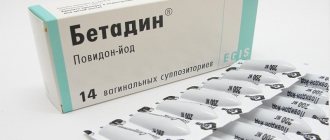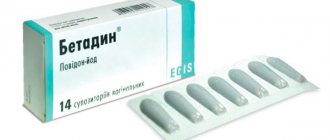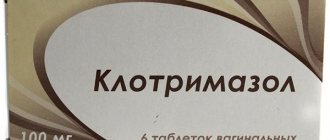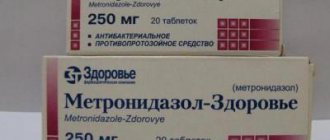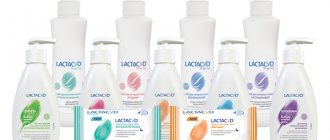Indications for the use of suppositories
The drug is active against fungi, bacteria, spores and viruses. The iodine contained in it quickly combines with the components of infectious agents and leads to their coagulation. Betadine is prescribed for infectious and fungal diseases of the genitourinary area. Among them:
- candidiasis;
- vaginitis (any form);
- bacterial vaginosis;
- trichomoniasis;
- genital herpes.
This drug is also used for preventive purposes before surgery, abortion, and childbirth. Taking it within two hours of unprotected sex may reduce the risk of contracting sexually transmitted infections.
Another likely cause may be the above-mentioned vaginal dysbiosis. Against the background of this phenomenon, an inflammatory process develops, which leads to various uncharacteristic discharges. It is worth considering, however, that in this case they will have a slightly different consistency. If in the first case the leaking liquid is very watery, then in the second it is thicker, mucous in structure, possibly even with clots.
Indications for use
Suppositories are often used in gynecological practice to treat many ailments. Before using the product, it is imperative to undergo an examination that will help to find out the true causes of the development of the pathological condition. To do this, women usually take a smear for microflora.
Most often, iodine-based suppositories are prescribed for thrush. Betadine also helps with other gynecological diseases. The drug may be prescribed in the following cases:
- for the treatment of bacterial vaginosis (a pathology characterized by a violation of the bacterial flora of the vagina);
- to eliminate the causes and symptoms of infection with Candida fungi;
- for the treatment of trichomoniasis caused by a fungal pathogen;
- for the treatment of chronic ailments and inflammatory processes in the vagina in the acute phase;
- to eliminate fungal diseases that have arisen while taking steroid hormones.
Many experts recommend using suppositories if antiseptic treatment of the vagina is necessary.
Description
Betadine suppositories are a powerful antiseptic and disinfectant
effective against cocci, fungi, viruses, E. coli and other pathogens of pathological infections.
Suppositories are used in gynecology for the treatment of vaginitis, infections caused by fungi of the genus Candida and trichomoniasis, bacterial vaginosis, as well as for the prevention of infectious complications
during diagnostic procedures and gynecological interventions.
Microorganisms do not develop resistance to this drug. After using vaginal suppositories, the vaginal microflora quickly normalizes
.
How does it work?
The active substance has an antiseptic effect. When iodine is released from the complex with polyvinylpyrrolidone, a film is formed on the vaginal mucosa, from which active iodine is released. The substance affects both gram-positive and gram-negative bacteria. Fungi, viruses, bacteria and protozoa exhibit sensitivity. Not affected by Mycobacterium tuberculosis.
The drug has a therapeutic effect at the local level. The active substance practically does not penetrate into the systemic circulation.
Pharmacology
The active ingredient of the drug is povidone-iodine. The spectrum of action of Betadine is wide, it extends to fungi, viruses and bacteria, due to the presence of iodine in the composition. Betadine is produced in three dosage forms:
- vaginal suppositories;
- solution;
- ointment.
The effect of use occurs instantly: 20 seconds after contact with the mucous membranes, most of the pathogenic microflora dies. For Betadine suppositories, indications for use may be as follows:
To block the irritating effect of iodine, polyvinylpyrrolidone is added to the medicine. Despite the concerns of patients, Betadine suppositories are well tolerated and do not cause serious side effects.
Long-term treatment with Betadine promotes the accumulation of iodine in the body. The concentration of this compound occurs especially quickly when treating large areas of skin or severe burns. The level of iodine in the blood normalizes two weeks after taking the last dose of the drug.
The drug Betadine must not be used simultaneously with other disinfectants, since their antiseptic effect is significantly reduced. First of all, this rule applies to hydrogen peroxide.
In addition, treatment with Betadine is contraindicated while using medications containing silver, taurolidine, and enzymes. The combination of these substances leads to the formation of alkaline mercury iodide. While taking Betadine, you should avoid lithium-containing medications (pills that are prescribed to treat mental illness).
Preparations similar to Betadine in composition:
- Vocadine;
- Iodosept;
- Polyiodine;
- Iodovidone;
- Iodoxide.
Composition and release form of Betadine
The drug is available in three dosage forms:
- Betadine ointment 10%. 1 g of ointment contains the active substance - povidone-iodine 10 mg. Additional components: purified water, sodium bicarbonate, macrogol. In tubes of 20 g.
- Solution for external use 10%. 1 ml of solution contains the active substance - povidone-iodine 10 mg. Additional components: glycerin, purified water, citric acid, disodium phosphate, nonoxynol, sodium hydroxide, anhydrous acid. Available in bottles of 30, 120 or 1000 ml.
- Betadine suppositories intended for vaginal use. One suppository contains 200 mg of povidone-iodine. Additional components: macrogol. There are 7 or 14 suppositories in a blister pack.
Betadine - instructions for use for thrush
This drug is a less pungent iodine compound, where it is bound by the low molecular weight absorbent povidone, which is often used in medicine.
An ordinary alcohol solution of iodine is a good antiseptic and a source of an essential mineral needed by the thyroid gland for the synthesis of thyroid hormones.
But when used even on smooth skin (not to mention mucous membranes), it burns too much, and “Betadine” for thrush is just what you need.
Compound
The list of components of the drug varies depending on the form of release, but the basis in all of them is the same - the above-mentioned surface antiseptic povidone-iodine. For 1 g of Betadine ointment, 100 mg of povidone and 10.25 mg of iodine are added. Plus, for its homogenization and preservation, macrogols 400, 4000, 1500 and 1000 are used.
When taken orally, these compounds give a pronounced laxative effect (they themselves are a medicine). And when applied externally, they are not absorbed and do not have a therapeutic effect - they only stabilize the easily exfoliated mixture of iodine with an absorbent due to the same ability to retain water, which also helps against constipation.
Suppositories for vaginal administration contain 200 mg of iodine directly with povidone and macrogols (also play the role of stabilizers of the mixture). In the form of a solution, in addition to 10 mg of betadine-iodine, the preservative citric acid, spermicide and antifungal used for local contraception nonoxynol, emulsifier sodium hydrogen phosphate, glycerin (thickener) and water are mixed.
"Betadine": release form
The product is produced in the form of:
- aqueous solution;
- ointments;
- suppositories for vaginal use.
All of the options listed are intended for local use and are not used internally.
Indications
Polyvinylpyrrolidone is used as an enterosorbent. It does not cure anything other than food poisoning. Locally, iodine acts as a bactericidal component, also effective against fungi and viruses. When absorbed systemically, it is all sent to the thyroid gland to produce thyroxine and triiodothyronine.
Periodic use of an alcohol solution of iodine serves as a good prevention of thyroid pathologies. But it should not be used on the face and lower extremities, as they are especially susceptible to the growth of vascular mesh with age. Locally, iodine itself is capable of accelerating capillary blood circulation, dilating blood vessels and leading to rosacea-varicose veins.
Its main disadvantages as an antiseptic are its high burning ability (locally, but both mucous membranes and smooth skin resistant to such influences) and absorption too fast for effective sanitation.
The reason for the latter is that the thyroid gland of the “land” population of the planet needs it constantly (liquidators at Chernobyl took 0.3-0.5 vials daily). The addition of povidone allows you to eliminate its listed disadvantages and use it for local sanitation for:
- injuries;
- infectious lesions of the skin/mucous membranes;
- trophic erosions;
- ulcers in diabetics, especially the lower extremities, caused by disturbances in capillary blood flow;
- preparation for surgery, punctures, biopsies;
- processing of fresh scars;
- installation of catheters or drainage routes;
- dental procedures (after stone removal, tooth extraction, formation of the gum line using coagulation, gingivitis, periodontal disease, etc.).
The percentage of systemic absorption of iodine is low (very different from that of drugs suitable for oral administration). And Betadine is not suitable for permanent compensation of its deficiency. It only acts locally, but for several hours.
A sign of the end of the therapeutic effect is the disappearance of a brown tint on the skin at the site of application (thanks to this base, all forms of the product have a brown color, and its disappearance means the depletion of the iodine contained in it).
Despite the low overall digestibility, the drug is not indicated for:
- hyperthyroidism;
- some hypothyroidism scenarios;
- thyroid cancer;
- pregnancy “older” than the first trimester;
- breastfeeding;
- allergies to iodine;
- The patient is under 8 years of age.
It should also not be used for 2 months. after therapy with radioactive iodine isotopes.
These are usually used in the treatment of thyroid cancer: it alone has an “appetite” for this mineral, and even molecules not assimilated by it will disintegrate in a maximum of a week, since the isotope is short-lived.
Iodine is ineffective against Koch's bacillus and is not used to treat tuberculosis of any organs, including the skin.
Betadine suppositories for thrush
This form is the main one for candidiasis in women, but is also suitable for rectal administration by men when the fungus is activated in the rectum or anal area. It’s just a relatively rare phenomenon, indicating a general immunodeficiency, although sometimes it is also observed with polyposis, colorectal cancer, after surgery on an organ for any reason.
“Betadine” suppositories for thrush are administered for vaginitis and vulvovaginitis (together with ointment or solution) moistened with water, up to 2 times, morning and evening (in the acute stage - and for moderately severe candidiasis, 1 suppository at night is enough), until disappearance symptoms plus 3-5 days.
They are allowed for use on menstrual periods (incompatible with tampons), but they themselves can stain underwear (require the use of panty liners or wearing dark underwear).
The schedule and wishes for rectal use are the same, only taking into account that the drug is not indicated for hemorrhoids.
How to use other types of medicine?
You can wipe the affected areas with an undiluted Betadine solution, douche (vagina, a little worse for the urethra), and make compresses with cotton wool and gauze. The procedures should be carried out twice a day, for 2-3 weeks. This antiseptic is incompatible with others based on enzymes, mercury, alkalis (including baking soda).
The ointment is applied to the affected areas (and, if desired, to the vaginal mucosa) up to 3 times a day, until the symptoms of relapse disappear, plus another 5 “warranty” days, in a thin, even layer. If necessary (the drug also stains clothes), the top of the application can be covered with a bandage made of gauze or plaster.
Efficiency
Candidiasis is not a disease - this pathogen belongs to the opportunistic microflora of the mouth, genital and solid waste tracts. Treatment of thrush with Betadine allows you to destroy its “mycelium” without having a systemic effect in 3-5 days. Therapy can also be extended, but if it does not help within 2 weeks, its further use is useless.
"Betadine": price and where to buy?
The product does not belong to the “first priority” and the state does not monitor its supply/cost. It's also not cheap:
- the ointment will cost 250-330 rubles. per tube 20 g;
- the price of candles ranges from 360-420 rubles. for 7 pcs. and 465-550 rub. for twice the volume;
- the solution is the cheapest - 150-175 rubles. for 30 ml, 260-305 rub. for 120 ml or 800-850 rubles. for an almost wholesale volume of 1 liter.
The ointment is the least popular among buyers due to its coloring properties, and is less common. But the solution and suppositories are constantly present in the assortment of most stationary pharmacies, and there are no difficulties with offers for them on the Internet.
Reviews
In general, patients who have used the drug highly appreciate the low frequency of its side effects and the improvement in the functioning of a healthy thyroid gland. Among the shortcomings, the most often mentioned is staining of mucous membranes, skin and clothing.
Asya, 24 years old: “I like Betadine because of the improvements in the thyroid gland. There’s never enough iodine, and I can’t stand seaweed. It’s soft, not like an alcohol solution, and it gets rid of thrush in 3 days (in the best case scenario, in the worst case scenario, the entire package of 7 candles will be used up).”
Felix, 29 years old: “But it didn’t suit my wife. She had candidiasis just during pregnancy. The doctor said the child may have problems with growth and development due to the thyroid gland. It seems that iodine is absorbed at such a time, but the child does not need as much. We used only a decoction of celandine and calendula.”
Vanessa, 31 years old: “After giving birth, the fungus began to worsen steadily before each menstruation... So, when I just weaned my son, the endocrinologist recommended Betadine - he says it’s hormonal, the thyroid gland is acting up. And yet, yes, within six months the circus with PMS stopped. Now I don’t use any other antiseptics.”
Source: https://lechenie-molochnicy.info/betadin-pri-molochnitse.html
Side effects of Betadine
According to reviews, Betadine is well tolerated by patients. Allergic reactions may occur on the mucous membranes and skin, manifested in the form of rash, itching, and hyperemia.
In case of predisposition, Betadine, according to reviews, may contribute to the development of hyperthyroidism.
Rarely, acute generalized reactions with hypotension or suffocation (anaphylactic reactions) may occur. Dermatitis with psoriasis-like elements may develop.
When applying the drug to large areas of the body (wounds, burns), negative reactions may occur from electrolyte metabolism (increased sodium concentration in the blood serum), metabolic acidosis, changes in osmolarity, impaired renal function (up to acute renal failure).
Method of use of Betadine and dosage regimen
Betadine ointment is used topically. Apply the drug in a thin layer to the affected areas of the skin 1-2 times a day. The duration of treatment is up to two weeks.
Betadine solution is intended for external use in both diluted and undiluted form. Do not use hot water to dilute the solution. An undiluted solution of Betadine is used to disinfect hands and treat the surgical field.
According to reviews, Betadine solution can be used 2-3 times a day.
When treating wounds and burns, surgical interventions, 0.9% sodium chloride solution or Ringer's solution is used to dilute the Betadine solution. Dissolve the drug immediately before use.
Immediately before use, Betadine suppositories are removed from the shell and slightly moistened. During treatment with candles, it is recommended to use sanitary pads. 1 suppository is inserted deep into the vagina before bed. The use of suppositories during menstruation is allowed. If necessary, the dosage can be increased to 2 suppositories per day. The duration of treatment is approximately one week.
How to use?
Vaginal suppositories with an antifungal effect are prescribed in various dosages. The duration of treatment can be 7-14 days. It is very important to treat your partner in parallel to avoid relapse of the disease. Men are usually prescribed antimycotic drugs in tablet form.
Betadine suppositories for thrush should be administered as deeply as possible. This is necessary so that the suppository can dissolve. It is better to use the medicine before bedtime. If the drug must be used in the morning, after administering the suppository, you should take a horizontal position and lie down for at least 30 minutes. Only in this case can the candle dissolve and begin to act.
The suppository must be administered while lying on your back. Do this with clean hands. It is recommended to use panty liners during treatment, as a small amount of the medication will leak out and may stain your underwear.
Contraindications
The use of Betadine during pregnancy should be under the supervision of a physician. Iodine easily penetrates the placenta, so the concentration of the substance can exceed permissible limits and cause fetal malformations.
Treatment with iodine-containing drugs is also contraindicated:
- patients with an enlarged thyroid gland;
- patients with Graves' disease;
- children under one year old;
- persons with impaired renal function;
- before and after a procedure involving the introduction of radioactive iodine into the body;
- patients diagnosed with bullous polymorphic dermatitis.
The use of Betadine for diseases of the urinary system is not recommended for people with individual iodine intolerance. Side effects occur rarely, mainly in women when using suppositories.
Vaginal suppositories have strong disinfectant properties, so they can irritate the mucous membranes of the vagina. At the beginning of treatment, some patients may experience the following side effects:
- burning at the site of insertion of the suppository;
- itching;
- redness and swelling;
- in rare cases, rashes in the form of small blisters.
When the body is intoxicated due to excessive accumulation of iodine, the following signs appear:
- metallic taste in the mouth;
- copious amounts of saliva;
- swelling of the conjunctiva of the eyes;
- sore throat;
- disruption of the digestive organs;
- heartburn;
- If you are hypersensitive to iodine, severe swelling of the larynx may develop, leading to suffocation.
Women planning a pregnancy should be aware that Betadine has a negative effect on sperm, reducing their motility. The ability to conceive is restored after treatment is completed.
Any dosage form of Betadine affects the composition of the blood and urine. Povidone-iodine oxidizes the liquid, which can cause the results of urine, blood, and scintigraphy tests to be incorrect.
Drug interactions
Betadine suppositories are a broad-spectrum antiseptic, which means the drug has a detrimental effect on bacteria and fungi.
The drug is based on a chemical substance such as polyvinylpyrrolidone iodine (povidone iodine). This compound, or rather a free iodine molecule, reacts with the sulfhydryl and hydroxyl groups of amino acids of bacteria, fungi and viruses, causing their oxidative damage.
In addition to antibacterial and antifungal effects, Betadine suppositories are also used as part of complex therapy for human papillomavirus infection of the genitals. The antiviral effect of povidone-iodine has been established, which makes it possible to fight not only thrush and vaginosis, but also condylomas.
The use of Betadine for genital condylomas is relevant after destruction in order to prevent relapse, the development of dysbiosis and thrush.
The criteria for recovery from thrush after using suppositories are:
- absence of symptoms of thrush;
- absence of yeast mycelium in smears from the genital tract;
- normalization of inflammation indicators: levels of leukocytes, epithelial cells, absence of “key” cells.
The drug is available in the form of suppositories, 7 or 14 pieces per package, as well as in the form of an ointment or solution.
The use of Betadine cannot be combined with other antiseptics, enzyme preparations, alkalis and mercury.
For complete treatment of thrush, immunocorrective therapy should be performed after the course.
Betadine for thrush is safe because it acts locally and has a water-soluble base, and is an effective medication.
The main active component of Betadine is povidone-iodine. After inserting the suppository, the drug is distributed over the vaginal mucosa in a thin, even layer, gradually releasing the active form of iodine. By binding to the protein structures of the pathogen cell, it forms iodamines, coagulates and causes their death. Clinically, this is manifested by the rapid elimination of symptoms that bother the patient:
- itching and burning in the external genital area;
- hyperemia and swelling;
- unpleasant-smelling discharge;
- discomfort during urination.
The product acts at the local level, but with long-term use, as practitioners note, systemic effects are possible. The result of this is an increase in iodine levels in the blood, which quickly decreases to normal after cessation of treatment. Women with normal thyroid function should not be afraid of any side effects.
In addition to its antimycotic effect, this drug can have a detrimental effect on bacteria. This property of Betadine suggests that it can be used both to treat candida lesions only and to combat mixed infections.
The drug does not have a negative effect on the normal flora of the vagina. When the number of lactobacilli decreases, it, on the contrary, helps to increase their number.
Another remarkable property of Betadine is that it is almost impossible for pathogens to develop resistance to its active ingredients.
Side effects
Rarely (≥ 1/10,000 -
—
hypersensitivity
—
contact dermatitis with the formation of psoriasis-like red small bullous elements, erythema, itching
Very rarely (
—
anaphylactic reaction
—
hyperthyroidism (sometimes accompanied by tachycardia or restlessness) may occur in patients with existing thyroid disease after using iodine in significant quantities (for example, long-term use of povidone-iodine to treat wounds or burns)
—
angioedema
Frequency unknown (frequency cannot be determined from available data)
—
hypothyroidism (may develop with long-term use with large surfaces treated)
—
changes in serum electrolyte levels and osmolarity**, metabolic acidosis**
—
acute renal failure**
** - can be observed after using iodine in significant quantities (for example, when treating burns)
Reports of suspected adverse reactions
Providing data on suspected adverse drug reactions is very important to enable continuous monitoring of the risk/benefit ratio of the drug. Health care professionals should provide information about any suspected adverse reactions to the contacts listed at the end of the instructions, as well as through the national reporting system.
Reasons for the development of thrush
Vaginal candidiasis is considered one of the most common female ailments. Most representatives of the fair sex have encountered unpleasant symptoms that arise from a fungal infection of the genitals. Currently, the resistance of the causative agent of the disease to the standard treatment regimen has increased significantly, and relapses of the disease often occur. This is due to a decrease in the body's defenses.
Thrush can occur in the following cases:
- with long-term antibiotic therapy;
- in case of metabolic disorders;
- with long-term use of hormonal contraceptives;
- when treated with medications that suppress the immune system;
- with severe pathologies of the endocrine system;
- with dysbacteriosis;
- in case of non-compliance with personal hygiene rules;
- for immunodeficiencies of various etiologies.
Correct therapy aimed at eliminating the real cause of the development of diseases can only be prescribed by a specialist. In some cases, a comprehensive approach to treating a fungal infection is sometimes required.
special instructions
During use of povidone-iodine, iodine uptake by the thyroid gland may be decreased, which may affect the results of some diagnostic tests (eg, thyroid scintigraphy, protein-bound iodine, radioiodine measurements), and may also interact with iodine supplements used. for the treatment of thyroid diseases. To obtain undistorted research results after long-term therapy with povidone-iodine, it is recommended to maintain a sufficiently long period of time (1-2 weeks) without this drug.
Due to the oxidizing properties of povidone-iodine, trace amounts of povidone iodine may cause false-positive results in some types of tests using toluidine or guaiac resin to detect occult blood (hemoglobin) in the stool or blood or glucose in the urine.
In case of skin irritation, contact dermatitis or hypersensitivity, the use of the drug should be discontinued.
Do not heat the drug before use.
Significant amounts of iodine can cause hyperthyroidism in patients with thyroid dysfunction (for example, nodular colloid or endemic goiter). In such patients, the use of Betadine vaginal suppositories should be limited in time and the area of the skin surface being treated. If symptoms of hyperthyroidism occur during treatment, thyroid function should be checked.
Vaginal suppositories Betadine has a fairly strong antiseptic and disinfectant effect on the tissue of the vaginal mucosa. The iodine-containing drug promotes the rapid death of various microorganisms. At the same time, the medicine is not addictive due to the characteristics of its composition; it is not absorbed into the blood, but has only a local effect. Suppositories have proven themselves well among specialists, however, some women observe a peculiar discharge after Betadine. Below we will look at the properties of the drug that can have a similar effect on the body.
Duration of treatment and features of use of the drug
Betadine suppositories are an antiseptic drug for candidiasis, intended for topical use. It contains polyvinylpyrrolidone and iodine. This combination of components is called Povidone-iodide.
Betadine suppositories for thrush have the following properties:
- antibacterial, antiviral;
- antiseptic, disinfectant;
- antiprotozoal and also antifungal.
When the iodine contained in Betadine comes into contact with the skin and mucous membranes, inhibition of pathogenic microorganisms is observed. The spectrum of iodine effects covers:
- viruses, protozoan microorganisms;
- Treponemas and fungi;
- acid-fast bacteria;
- gram-positive and negative bacteria.
Betadine for thrush has several forms of release. These are mainly: ointments, solutions, suppositories, aerosols. Features and indications for taking Betadine:
- thrush;
- vaginosis;
- treatment of wounds and injuries;
- preparation for surgery;
- prevention, treatment of complications of people who have probes, catheters, drainages;
- genital herpes.
Before using betadine in the treatment of thrush, it is necessary to familiarize yourself with the peculiarities of prescribing each form of the drug. Betadine ointment is best used for treating cuts and abrasions, bedsores, ulcers, as well as for the treatment of mixed and fungal infections.
The most popular are Betadine suppositories, which are indicated for use during acute forms of vaginosis, vaginal lesions, genital herpes, and trichomoniasis infection. Another form is a solution. It is recommended to be used for antiseptic treatment of mucous membranes, skin and burns.
Before we talk about why brown, white discharge or bloody discharge appears after using Betadine, it is necessary to talk about the drug itself and its effect on the body. This medication is available in the form of vaginal suppositories, which are inserted into the vagina 1-2 times a day (the dosage is prescribed individually).
Its active components ensure the rapid death of various pathogenic microorganisms present in the vagina, but at the same time they are not addictive and are not absorbed into the blood, which is why they almost never provoke side effects.
Betadine is active against fungi, viruses, spores and bacteria. Iodine, which is in its composition, reacts with pathogens for a short time and promotes their coagulation, after which it removes them from the vagina naturally.
As a rule, these vaginal suppositories are used for the development of various infectious and fungal diseases of the genital area, including:
- all types of vaginitis;
- genital herpes;
- thrush (candidiasis);
- trichomoniasis;
- vaginosis of bacterial origin.
In addition, Betadine is actively used before various gynecological surgical interventions, as well as before the opening of labor as a prevention of complications during the rehabilitation period.
They are also recommended for use by women who plan to become pregnant in the near future in order to reduce the risk of developing various diseases in the first trimester, which can negatively affect the development of the fetus.
However, the use of Betadine may be accompanied by various symptoms, including not only beige, yellow, pink, bloody or brown discharge, but also itching, burning in the intimate area, genital hyperemia, etc. All this is a consequence of similar effects of the drug, including:
- allergic reactions caused by intolerance to one of the components included in the suppository;
- thyrotoxicosis, which is characterized by an excess of iodine in the body (observed either against the background of a hereditary predisposition, or when the drug is taken for a very long time);
- dysbacteriosis, in which there is a violation of the vaginal microflora. Observed with prolonged and uncontrolled use of suppositories.
Candidiasis is a fungal infectious disease that provokes an inflammatory process in the mucous membrane of the vagina, stomach and intestines, oral cavity and even nasopharynx. For the treatment of vaginal candidiasis, the use of suppositories is recommended, as they are recognized as the most effective and safe.
Betadine candles deserve special attention, they are recognized as the most popular and in demand among modern women. These suppositories can be used not only against candida fungi, but also against microorganisms of a different nature.
The drug has both its indications and contraindications, as well as side effects. It is necessary to start treatment after a doctor’s prescription.
Indications
Betadine suppositories are used in the following cases:
- acute and chronic infectious processes of the vagina;
- bacterial vaginosis;
- genital herpes;
- trichomonas infection;
- transvaginal surgical operations;
- fungal infections of the vagina after using steroid drugs.
Side effects
In some cases, the drug can cause the following unpleasant side effects, when they occur, stop using it:
- allergic reaction to iodine in the form of itching and redness;
- in severe cases, an anaphylactic reaction may occur in the form of attacks of suffocation and a sharp drop in blood pressure;
- psoriasis-like dermatitis;
- renal dysfunction.
Solution
Thrush is the result of the proliferation of pathogenic microflora. Betadine for thrush successfully eliminates the causative agent of the disease, disinfects the mucous membranes and prevents the development of serious complications, for example, adhesions, uterine hyperplasia and others.
Betadine is an effective treatment, acting directly on the cause of thrush. But its use is advisable under the supervision of a doctor and only after prescription. Otherwise, there is a high probability of adverse reactions and complications.
Contraindications for the use of betadine are also Dühring's dermatitis herpetiformis (a severe skin disease of unknown origin, which is characterized by severe itching and a wide variety of skin rashes), a condition that occurs during treatment of increased thyroid function with radioactive iodine, pregnancy (II and III trimesters - may the thyroid gland of the fetus may be damaged), feeding the child Breastfeeding is a personal choice of breastfeeding (iodine is excreted in breast milk) and individual intolerance to the drug.
The standard treatment regimen for thrush with Betadine involves the use of one suppository per day for a week. But the number of suppositories per day can be doubled, and the course extended to two weeks according to the doctor’s decision. Such measures are usually necessary for persistent infections and the spread of the inflammatory process.
Betadine will help get rid of thrush only if the treatment regimen is prescribed by a gynecologist. Self-prescription and use of suppositories is fraught with side symptoms and the development of complications of thrush.
But, as a rule, gynecologists “do not welcome” such treatment and instead prescribe treatment with various creams and topical ointments, which include Betadine suppositories for acute thrush. Do Betadine suppositories help with vaginal thrush, how do they work? How should they be used? How long does the treatment last? Let's try to figure it out.
When it comes into contact with the vaginal mucosa, betadine is distributed over the surface and acts mainly locally, but if the suppositories are used for a long time, then their systemic effect is possible due to entry into the blood.
The concentration of iodine in the blood increases, but not for long: when the drug is discontinued, everything goes away quickly (within one to two weeks), without causing any changes in women with normal thyroid function. Iodine is excreted in the urine.
Betadine is contraindicated for the treatment of thrush in cases where there are iodine-dependent pathologies of the thyroid gland: adenoma, goiter, Graves' disease, thyrotoxicosis. With these pathologies, the entry of iodine into the blood can significantly worsen the state of health and cause a relapse.
The medicine for thrush is selected in such a way as to act directly on its cause. The causative agent of thrush is a fungus of the genus Candida, which is why thrush is also called candidiasis. Uncontrolled proliferation of the fungus occurs for various reasons, but the treatment for candidiasis is always the same - restoration of healthy microflora and elimination of the fungus, which is what Betadine copes with.
Thrush may be accompanied by pain when urinating. Pain in the lower abdomen indicates the spread of the inflammatory process to the internal organs of the reproductive system. Such symptoms are observed in advanced forms of thrush.
Betadine is a drug whose active ingredient is povidone-iodine, which gives the drug the right to be listed as an antiseptic. Betadine has a wide spectrum of action against pathogens, fungi and viruses.
The main active ingredient is povidone-iodine. In 1 suppository it is 200 mg, and macrogol 1000 acts as an auxiliary component. Povidone-iodine has pronounced antiseptic, antifungal, antiprotozoal and disinfectant properties.
That is, the drug has a detrimental effect on the cell walls of pathogenic microorganisms, for example, Staphylococcus aureus, Escherichia coli, fungi, viruses, and protozoa. Once on the mucous membranes or skin, iodine is released from the complex and interacts with the proteins of the cell wall of the pathogenic flora, iodine, destroys them and causes further death of both gram-negative and gram-positive bacteria.
Moreover, during local application, iodine is almost not absorbed into the blood. The mechanism of action of Betadine does not allow harmful microorganisms to develop resistance to the drug. And many modern antibacterial drugs, if they are constantly used incorrectly, cease to have a therapeutic effect, that is, they do not destroy the causative agents of the disease.
Side effects
Bloody discharge after suppositories
In addition to the above, they may occur due to injury to the vaginal mucosa.
This may occur as a result of increased sensitivity of the internal genital organs due to certain phenomena. An allergic reaction to Betadine often causes increased blood flow to the tissues, which can also affect the susceptibility of the mucous membrane to a particular intervention.
In any case, it is better to consult a doctor to definitely find out the cause of the uncharacteristic discharge. Perhaps this is an individual reaction to the drug. Before using iodine-containing suppositories, your gynecologist should warn you about the possibility of brown spots appearing on your panty liner or underwear. If nothing else bothers you, then it is likely that the discharge is just the result of the product leaking out.
Betadine is an antiseptic drug.
Storage conditions
Betadine ointment should be stored in a dark place for no longer than three years.
Betadine suppositories are stored at temperatures up to 15 degrees for no longer than five years.
Betadine solution is stored at temperatures up to 15 degrees for no longer than three years.
Betadine suppositories are a universal medicine
, which is used to treat various
gynecological diseases
.
Due to its antimicrobial and antiseptic properties, this drug is highly effective
when using it. Let's take a closer look at what Betadine suppositories are, instructions for use, price, reviews about this medicine. A photo of the drug will also be presented in the article.
Recommendations for treatment
Solution
The latter include not only diseases against which thrush develops. It can also develop during pregnancy. During this period, the amount of progesterone increases, as a result of which the vaginal microflora becomes more acidic. This becomes a condition for the growth of the fungus.
Systemic antifungal drugs, that is, those that should be taken orally, may also be additionally prescribed. Can the drug be used during menstruation? This medicine can be used during menstruation, they do not affect its effectiveness.
So, how to use Betadine suppositories? Betadine suppositories are inserted into the vagina once a day. Before using suppositories, it is necessary to clean the mucous membranes, then take a lying position and insert the suppository deep into the vagina.
Treatment regimens, choice of drug for thrush, their combinations, type of treatment (local or combined), duration of the course are determined exclusively by the doctor!
Currently, the choice of drugs for the treatment of thrush is quite extensive, and the choice of release forms for such drugs is varied. Information on their use is available. But it is worth remembering that you should not self-medicate for thrush to achieve the best result (with irrational therapy, the acute disease turns into a chronic form resistant to most drugs). The main groups of drugs that are used to treat thrush:
- antibiotics of the polyene group (Natamycin, Nystatin);
- triazole derivatives (Fluconazole);
- imidazoledioxalane derivatives (Livarol);
- imidazole derivative (Clotrimazole).
For acute thrush, it is possible to use local forms (vaginal tablets and suppositories, ointments, creams) of medications. While in chronic (long-term) or recurrent (often recurring) forms of the disease, the use of tablet forms of the drug together with local treatment is inevitable and necessary.
The most common forms of drug release for the treatment of thrush are tablets and suppositories. You can find out which one is better to use by reading the following articles:
- Tablets for the treatment of thrush
- Candles against thrush
- Ointment for thrush
When taking suppositories, it is necessary to place material in the form of a thick pad, since suppositories become liquid at temperature and flow out of the vagina. Iodine is practically not absorbed through the vagina and does not enter the general bloodstream.
Tags: betadine, thrush, help About the author: Admin4ik
« Previous entry
